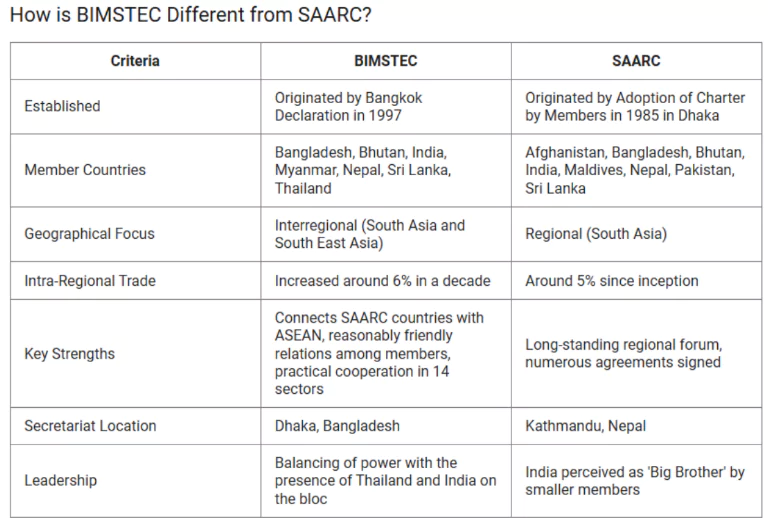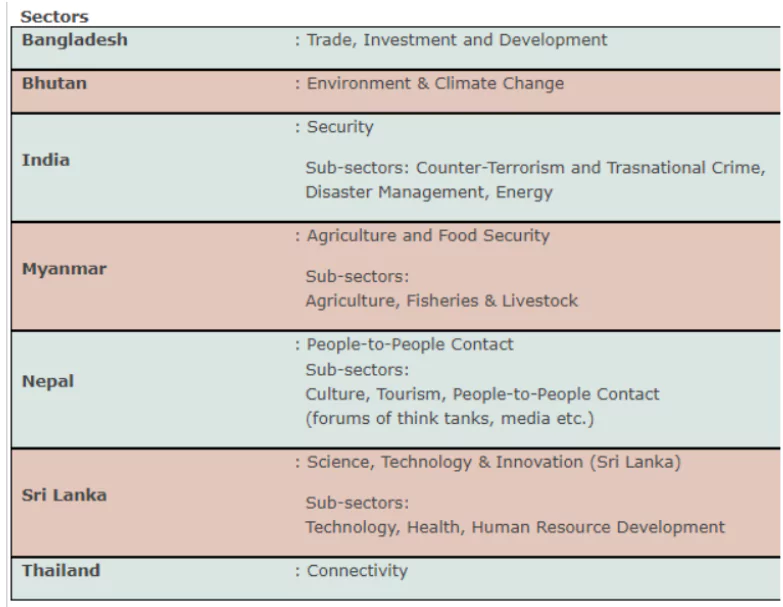The intent of BIMSTEC member states to push forth with a bold vision for the region was evident at the 2nd Foreign Ministers’ Retreat.
What is the BIMSTEC Grouping?
- About:
- BIMSTEC is a regional organisation comprising 7 member states – Bangladesh, Bhutan, India, Myanmar, Nepal, Sri Lanka, and Thailand.
- It was formed in 1997 with the aim of promoting multifaceted technical and economic cooperation among the countries of the Bay of Bengal region.
- The region covered by BIMSTEC is home to around 1.5 billion people, with a combined GDP of over USD 3.8 trillion.
- Origin:
- The sub-regional organisation was established in 1997 with the adoption of the Bangkok Declaration.
- Initially consisting of 4 Member States, it was known as ‘BIST-EC’ (Bangladesh, India, Sri-Lanka and Thailand Economic Cooperation).
- In 1997, it was renamed ‘BIMST-EC’ after Myanmar joined.
- The admission of Nepal and Bhutan in 2004 led to another name change to the ‘Bay of Bengal Initiative for Multi-Sectoral Technical and Economic Cooperation’ (BIMSTEC).
Enroll now for UPSC Online Course
Strengthening Ties with Eastern Neighbours
- BIMSTEC is the regional organisation devoted to the Bay of Bengal, with a membership of five South Asian and two Southeast Asian countries, cooperating across seven diverse sectors.
- It allows New Delhi to engage multilaterally with the other countries of the Bay of Bengal region, which are its eastern neighbours and therefore vital for its economic development, security, and foreign policy imperatives.
- India also remains intent on solidifying relations with its eastern neighbours as China’s growing presence in the Bay of Bengal poses a potential threat to regional stability and New Delhi’s position as a preferred security partner in these waters.
A New Push in the Bay of Bengal
- India hosted the 2nd BIMSTEC (Bay of Bengal Initiative for Multi-Sectoral Technical and Economic Cooperation) Foreign Ministers’ Retreat in New Delhi earlier this month with a focus on providing an “informal platform to discuss ways and means of cooperating and accelerating action in security, connectivity, trade, and investment within the Bay of Bengal.”
- The retreat was held in preparation for the sixth summit meeting, scheduled for September, in which the BIMSTEC leaders will meet in person for the first time in the post-pandemic era.
- They are also expected to sign the BIMSTEC Agreement on Maritime Transport Cooperation to improve regional connectivity — a foundational aim of this grouping.


Check Out UPSC NCERT Textbooks From PW Store
Two Parts of the Retreat
- The retreat was divided into two parts.
- In the first segment, participants assessed the current state of regional cooperation within BIMSTEC, building on a presentation by India on the implementation of key outcomes of the 1st Retreat.
- Multiple ideas were shared by the member states including the establishment of Centers of Excellence in member states, focusing on Agriculture, Disaster Management, and Maritime Transport.
- India announced support for cancer research, treatment, and issuance of e-visas for patients of all BIMSTEC states, while Sri Lanka proposed the inclusion of kidney disease.
- The need for involving the private sector in trade and promoting young entrepreneurs was also highlighted, as was the importance of connectivity, cyber-security, and countering the trafficking of narcotics and illegal arms.
- In the second session, the expectations of each country from the forthcoming summit were discussed.
- Sri Lanka underscored the need to map mineral resources found in abundance in the BIMSTEC countries and create opportunities for the vertical integration of stages of production within specific sectors in the economies of the countries, enabling them to diversify their production structure.
- Bangladesh highlighted the need for cooperation in the Blue Economy and urged member states to ban fishing during the breeding season to address the problem of depleting catch in the Bay.
- Bhutan expounded on the need for collaboration in tourism and cultural exchanges, while Nepal highlighted its ‘whole of the region’ approach to leverage synergies among member states and transform BIMSTEC into a results-oriented regional forum.
- Thailand underscored the need for cooperation in non-traditional security domains, and Myanmar added the need to combat online scamming to the list.
- These proposals will be presented to the heads of state before the September summit.
Bilateral Merits
- While the retreat was a multilateral milestone for India, it had its bilateral merits too.
- Mr. Jaishankar met several of his counterparts on the sidelines.
- He shared with Myanmar India’s concerns over the flow of displaced persons, narcotics, and arms across the border and urged for the return of unlawfully detained Indians.
- He also held a meeting with the Bangladesh Foreign Minister, who requested him to ensure the smooth supply of daily essentials and send a technical team for the Teesta project, signifying another step towards easing this long-pending concern.
- At the end of the retreat, the Foreign Ministers called on Prime Minister Narendra Modi.
- This year marks a decade of India’s Act East and Neighbourhood First policies, and the thrust on BIMSTEC is a manifestation of New Delhi’s efforts to continue nurturing collaborative growth for national and regional well-being.
- Thus, Mr. Jaishankar encouraged future collaborations through new energies, resources, and a renewed commitment to cooperation.
Enroll now for UPSC Online Classes
Conclusion
BIMSTEC strengthens regional cooperation among seven member states, enhancing economic, security, and foreign relations, with a focus on connectivity and collaborative growth in the Bay of Bengal.
![]() 27 Jul 2024
27 Jul 2024



